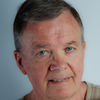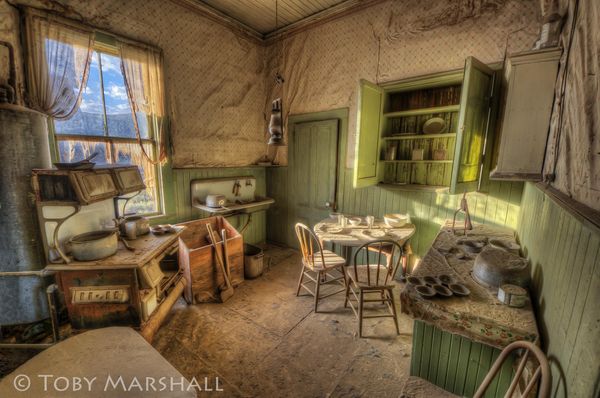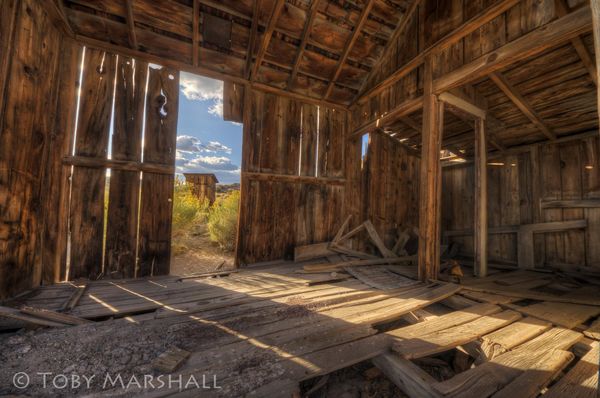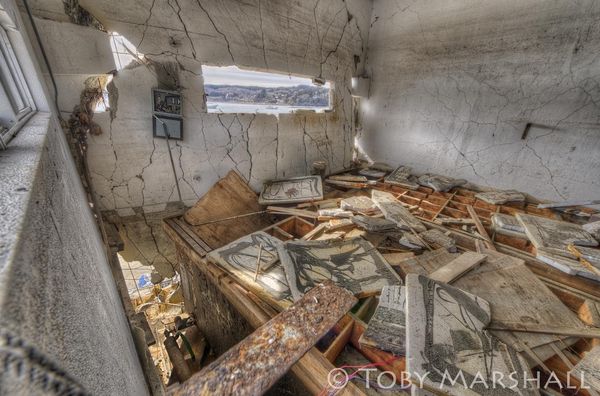Need help with wide angle lens for indoor photography
Apr 16, 2015 10:05:01 #
I use the Sigma 8-16 on my Canon T3i and I just love it. Have never had a problem in lower light situations, and love the ability to get everything in my photo.😊
Apr 16, 2015 10:06:15 #
jrbissell wrote:
This may have been overstated but with my nikon d3... (show quote)
Just bounce it off the ceiling, and use a flash bracket to get it way off camera. Direct flash from a peanut-sized reflector is nasty, anyway, unless it comes through a large umbrella or a halo or soft box.
Apr 16, 2015 10:19:00 #
Don Fischer
Loc: Antelope, Ore
I have a nephew that does mostly articular (sp) photography, does it for a living. I asked him about flash once and he doesn't use it either. He get's photo's like above. I asked a real Estate agent about photo's one time and he told me he does his own with a disposable camera, film days.
Apr 16, 2015 10:21:31 #
Another remedy is to turn camera up side down and the on camera flash will bounce off floor. A very make shift at best.
The real question is, in my mind there are not a UWA that I would not use. And many used on the secondary market at give away pricing. Reason many people don't see or know how to use UWA.
J. R.
The real question is, in my mind there are not a UWA that I would not use. And many used on the secondary market at give away pricing. Reason many people don't see or know how to use UWA.
J. R.
jrbissell wrote:
This may have been overstated but with my nikon d3... (show quote)
Apr 16, 2015 10:33:25 #
amfoto1
Loc: San Jose, Calif. USA
It's hard to beat the Canon EF-S 10-22mm USM... one of the best in the ultrawide class. I use one.
I also have a Tokina 12-24/4... if shooting with manual flash this or one of the other Tokina with a non-variable aperture is a lot easier than the zooms with variable apertures, which is the case with most in the ultrawide class.
Canon also is now offering EF-S 10-18mm STM IS, a real bargain at $300 list price. Seems nearly as good as the older 10-22mm. Note that the cheaper lens has IS. It's STM AF is a slight downgrade from USM for still photography, but STM can be better for video... OTOH, the 10-22mm is a bit better built (a little less plasticky).
You'll have to be careful with any of these lenses. They tend to have pretty strong distortion effects at the widest settings. The wider the focal length, the more perspective and anamorphic distortions you'll see. That's just the nature of very wide angle optics. The Canon 10-22mm is about as well corrected as possible. Same with the Tokina 12-24mm. Any lens you are considering you should look up test shots done with it (http://www.the-digital-picture.com/ has tested many) and check for barrel/pincushion... Or, even worse, look for "mustache" distortion, which is harder to correct in post-processing (for example, the Samyang/Rokinon 14/2.8 has a lot of this type of distortion). Also watch out for edge/corner softness. It can be a problem with ultrawides, particularly when used "wide open".
One solution to minimize distortions is to take multiple shots using a less extreme focal length and then combine the images using a panoramic software.
The only f2.8 lens in the ultrawide category is from Tokina... Their 11-16mm has been around for a while now (two versions, but little difference between them in Canon mount)... it's quite sharp, but also prone to flare. And to get f2.8 you give up much range of focal lengths. Tokina has a new 11-20/2.8 coming out, though, to supersede the 11-16mm.
Sigma offers an f3.5 (non-variable) 10-20mm, but it's rather expensive and one of the largest/heaviest in the ultrawide category. Not to be confused with their cheaper 10-20mm with variable aperture.
The things is, you hardly need f2.8 or even f3.5 for this type of photography. You'll almost certainly be stopping down for best sharpness and adequate depth of field anyway. A big aperture would be pretty low on my feature wish list, for this type of lens. Use a tripod and smaller apertures/slower shutter speeds will not be a problem.
Use a flash. Actually for interiors multiple flashes would typically be better. A friend of mine is one of the top architectural photographers... He arrives with a van full of lighting gear and sometimes spends 8 or 10 hours setting up for a few shots. (http://luhnphoto.com/architecture/). Jeff loves digital since, for example, he no longer needs to balance interior and exterior light. Now he'll just take two shots... One exposed for the interior, the other for the exterior... And then combine them in Photoshop. Much, much easier than the days of film when you had to greatly boost interior lighting, as well as change out all the tungsten interior bulbs with special daylight bulbs, to get the inside to balance with the scene out the windows.
One of the shots on his website (room with piano), even without trying to balance exterior, required something like two dozen carefully balanced light sources to make for a very "natural" but well-lit interior Looks simple, but sure isn't!
I also have a Tokina 12-24/4... if shooting with manual flash this or one of the other Tokina with a non-variable aperture is a lot easier than the zooms with variable apertures, which is the case with most in the ultrawide class.
Canon also is now offering EF-S 10-18mm STM IS, a real bargain at $300 list price. Seems nearly as good as the older 10-22mm. Note that the cheaper lens has IS. It's STM AF is a slight downgrade from USM for still photography, but STM can be better for video... OTOH, the 10-22mm is a bit better built (a little less plasticky).
You'll have to be careful with any of these lenses. They tend to have pretty strong distortion effects at the widest settings. The wider the focal length, the more perspective and anamorphic distortions you'll see. That's just the nature of very wide angle optics. The Canon 10-22mm is about as well corrected as possible. Same with the Tokina 12-24mm. Any lens you are considering you should look up test shots done with it (http://www.the-digital-picture.com/ has tested many) and check for barrel/pincushion... Or, even worse, look for "mustache" distortion, which is harder to correct in post-processing (for example, the Samyang/Rokinon 14/2.8 has a lot of this type of distortion). Also watch out for edge/corner softness. It can be a problem with ultrawides, particularly when used "wide open".
One solution to minimize distortions is to take multiple shots using a less extreme focal length and then combine the images using a panoramic software.
The only f2.8 lens in the ultrawide category is from Tokina... Their 11-16mm has been around for a while now (two versions, but little difference between them in Canon mount)... it's quite sharp, but also prone to flare. And to get f2.8 you give up much range of focal lengths. Tokina has a new 11-20/2.8 coming out, though, to supersede the 11-16mm.
Sigma offers an f3.5 (non-variable) 10-20mm, but it's rather expensive and one of the largest/heaviest in the ultrawide category. Not to be confused with their cheaper 10-20mm with variable aperture.
The things is, you hardly need f2.8 or even f3.5 for this type of photography. You'll almost certainly be stopping down for best sharpness and adequate depth of field anyway. A big aperture would be pretty low on my feature wish list, for this type of lens. Use a tripod and smaller apertures/slower shutter speeds will not be a problem.
Use a flash. Actually for interiors multiple flashes would typically be better. A friend of mine is one of the top architectural photographers... He arrives with a van full of lighting gear and sometimes spends 8 or 10 hours setting up for a few shots. (http://luhnphoto.com/architecture/). Jeff loves digital since, for example, he no longer needs to balance interior and exterior light. Now he'll just take two shots... One exposed for the interior, the other for the exterior... And then combine them in Photoshop. Much, much easier than the days of film when you had to greatly boost interior lighting, as well as change out all the tungsten interior bulbs with special daylight bulbs, to get the inside to balance with the scene out the windows.
One of the shots on his website (room with piano), even without trying to balance exterior, required something like two dozen carefully balanced light sources to make for a very "natural" but well-lit interior Looks simple, but sure isn't!
Apr 16, 2015 11:16:46 #
erickter
Loc: Dallas,TX
saparoo wrote:
I really need advice on the best wide angle lens for real estate photography. For now, my budget is about $600. I shoot with a canon 60D. I'm looking at the canon 10-22mm f3.5-4.5. It has good reviews for landscape but can't find much on indoor/lowlight. Suggestions muchly appreciated.
Iam an architect and Have that lens. I've used it extensively for interior and exterior architecture with excellent results for the past 7 years. Landscapes too.
Works only on crop Canons (EFS).
Apr 16, 2015 11:27:29 #
erickter wrote:
Iam an architect and Have that lens. I've used it extensively for interior and exterior architecture with excellent results for the past 7 years. Landscapes too.
Works only on crop Canons (EFS).
Works only on crop Canons (EFS).
I have a $15 "fix" that allows me to use this lens on my full frame cameras! Saved me a lot of money (did not have to buy a 16-35 MM because of this fix).
Apr 16, 2015 12:09:07 #
If you would be happy with a prime, I use SIGMA 15mm f2.8. Seems like it would be useful in most real estate locations, but some shots might need distortion correction in Lightroom. It was $600.
Apr 16, 2015 12:11:07 #
When called to do realestate shots I use my Canon EF 10-22mm for exterior shots, using the 7D Mark II. But quickly shoot my indoor shots with my 6D, with Canon 16-35mm f2.8L wide angle, or Tamron 24-70mm f2.8 VC. As far as lighting I'll ask the agent to hold a silver reflector to catch the ambient. I'll also use a on camera flash for those tight spaces, but add a flash bender. I'm not concerned about the lighting outdoors with the 10-22, It's always bright enough in La. and if not I'll adjust the ISO. Almost all my realestate shots are of the "Mc Mansion" homes, so a UWA is really a necessity, not only for the houses but for the surrounding gardens.
B
B
Apr 16, 2015 12:23:57 #
It's probably important to note that MOST real estate photography today is destined to sell houses over the Internet, via sites such as Zillow, Trulia, and the MLS.
My wife and I bought and sold a house last summer, and the process was VERY different than it was in 2000 when we bought the house we sold in 2014. We looked at EVERY house we toured, online *first,* and studied the details in the comfort of our living room, *before* we scheduled a tour through our agent.
Most Realtors will tell you that real estate under a $million is not worth spending a lot of money or time trying to make it look perfect. They want it to look real, attractive *enough*, and most of all, clearly visible and realistic. You want to see every room, the exterior, and the yard, but they're only going to put "neat, clean, uncluttered" photos online. And they want at least a dozen, up to three dozen, depending on the size of the property.
That means that dragging in lights, setting up tripods, and doing HDR on site is probably not going to pay off, unless the client warrants it.
The photographer who covered our house worked VERY quickly, but she paid careful attention to composition, squaring up horizon lines and making sure the 10mm perspective didn't create odd angles. Her exposures mixing flash and ambient were dead on, and the post-processing done managed to even out the lighting in even the deepest rooms we had.
Was it perfect? No. It WAS good enough (see my earlier post). The Realtor I worked with sells a house every 1.8 days, and the photographers she uses work with several such busy Realtors! They don't charge a lot per assignment, but they do a very good, very consistent job, and they have a money making formula for it. They're doing well, driving nice cars, and paying their ways through graduate school.
My wife and I bought and sold a house last summer, and the process was VERY different than it was in 2000 when we bought the house we sold in 2014. We looked at EVERY house we toured, online *first,* and studied the details in the comfort of our living room, *before* we scheduled a tour through our agent.
Most Realtors will tell you that real estate under a $million is not worth spending a lot of money or time trying to make it look perfect. They want it to look real, attractive *enough*, and most of all, clearly visible and realistic. You want to see every room, the exterior, and the yard, but they're only going to put "neat, clean, uncluttered" photos online. And they want at least a dozen, up to three dozen, depending on the size of the property.
That means that dragging in lights, setting up tripods, and doing HDR on site is probably not going to pay off, unless the client warrants it.
The photographer who covered our house worked VERY quickly, but she paid careful attention to composition, squaring up horizon lines and making sure the 10mm perspective didn't create odd angles. Her exposures mixing flash and ambient were dead on, and the post-processing done managed to even out the lighting in even the deepest rooms we had.
Was it perfect? No. It WAS good enough (see my earlier post). The Realtor I worked with sells a house every 1.8 days, and the photographers she uses work with several such busy Realtors! They don't charge a lot per assignment, but they do a very good, very consistent job, and they have a money making formula for it. They're doing well, driving nice cars, and paying their ways through graduate school.
Apr 16, 2015 12:36:47 #
I've used HDR for my exterior shots. Never thought of using it for indoor shots. I just tried it on one of my old images using Photomatix. The original image was a lighted hallway that came out a little too dark. When I did HDR to it, it came alive. Panos is a good idea too.
DavidPine wrote:
I shoot architectural real estate photography. I u... (show quote)
Apr 16, 2015 12:38:19 #
DavidPine wrote:
I shoot architectural real estate photography. I use a 14-24 f/2.8, a 24mm shift-tilt, a RRS Gimble tripod head. Lightroom, ViewPoint2 and Perfect Effects. I shoot HDR and panos. I don't use lighting in real estate photography because time doesn't allow for all the setups. ... It's not easy dealing with the lighting, exposure and distortion but I find it rewarding and challenging. Good luck.
Great picture, David! Makes me want to buy the bedroom set at least if not the whole lovely house. In a prior life I took hundreds of photos of commercial real estate owned, financed or occupied by a large insurance company in Chicago. At the time my camera was frequently a highly compact Rollei 35, hand held and great in low-light situations. Needed to record general asset condition, occupancy, maintenance issues, ingress/egress and access. Some of the pictures were later used to market the properties when it came time to sell. I greatly enjoyed the daily variety of that work.
Apr 16, 2015 12:54:08 #
I have a lot of WA lens's--fixed and zoom--but the one I reach for is the Sigma 8-16--it is very close to how the eye sees things, and used vertical to create panoramas it is unmatched
Stan
Stan
Apr 16, 2015 13:06:57 #
DavidPine
Loc: Fredericksburg, TX
Thank you.
rjaywallace wrote:
Great picture, David! Makes me want to buy the bed... (show quote)
Apr 16, 2015 13:12:04 #
The Canon 10-22 is a very good lens, without a lot of distortion at the wide end, but it does tend to have a fair amount of CA. I have been very happy with the Sigma 8-16, which is very sharp corner to corner, and the widest rectilinear lens for crop sensor. It also tends to be pretty good with flare. Don't be fooled, 8mm is significantly wider than 10mm, which can be important indoors. F4.5 is of course slower than some UWAs, but anyway you want to use a tripod inside to frame the shots correctly, so no problem there really.
The only other UWA lens as sharp as the Sigma is the Tokina 11-16, and it is constant f2.8, but it has some real issues with flare and with quite bad CA. I still have mine but I have never used it since getting the Sigma 8-16. Also 11mm is significantly longer than 8mm. I highly recommend the Sigma. I am now using full frame and shooting with the Nikon 14-24, but still carry the Sigma and shoot in DX mode to take advantage of its flare resistance and extra coverage.
Here are two HDR shots from the ghost town of Bodie, and a wide shot showing tsunami damage near Fukushima, which are about as close to to real estate shots as I have, LOL. These are all at 8mm; 10 or 11 wouldn't have cut it...
The only other UWA lens as sharp as the Sigma is the Tokina 11-16, and it is constant f2.8, but it has some real issues with flare and with quite bad CA. I still have mine but I have never used it since getting the Sigma 8-16. Also 11mm is significantly longer than 8mm. I highly recommend the Sigma. I am now using full frame and shooting with the Nikon 14-24, but still carry the Sigma and shoot in DX mode to take advantage of its flare resistance and extra coverage.
Here are two HDR shots from the ghost town of Bodie, and a wide shot showing tsunami damage near Fukushima, which are about as close to to real estate shots as I have, LOL. These are all at 8mm; 10 or 11 wouldn't have cut it...
If you want to reply, then register here. Registration is free and your account is created instantly, so you can post right away.











